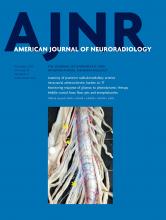Abstract
BACKGROUND AND PURPOSE: Hemorrhagic contusions are associated with iodine leakage. We aimed to identify quantitative iodine-based dual-energy CT variables that correlate with the type of intracranial pressure management.
MATERIALS AND METHODS: Consecutive patients with contusions from May 2016 through January 2017 were retrospectively analyzed. Radiologists, blinded to the outcomes, evaluated CT variables from unenhanced admission and short-term follow-up head dual-energy CT scans obtained after contrast-enhanced whole-body CT. Treatment intensity of intracranial pressure was broadly divided into 2 groups: those managed medically and those managed surgically. Univariable analysis followed by logistic regression was used to develop a prediction model.
RESULTS: The study included 65 patients (50 men; median age, 48 years; Q1 to Q3, 25–65.5 years). Twenty-one patients were managed surgically (14 by CSF drainage, 7 by craniectomy). Iodine-based variables that correlated with surgical management were higher iodine concentration, pseudohematoma volume, iodine quantity in pseudohematoma, and iodine quantity in contusions. The regression model developed after inclusion of clinical variables identified 3 predictor variables: postresuscitation Glasgow Coma Scale (adjusted OR = 0.55; 95% CI, 0.38–0.79; P = .001), age (adjusted OR = 0.9; 95% CI, 0.85–0.97; P = .003), and pseudohematoma volume (adjusted OR = 2.05; 95% CI, 1.1–3.77; P = .02), which yielded an area under the curve of 0.96 in predicting surgical intracranial pressure management. The 2 predictors for craniectomy were age (adjusted OR = 0.89; 95% CI, 0.81–0.99; P = .03) and pseudohematoma volume (adjusted OR = 1.23; 95% CI, 1.03–1.45; P = .02), which yielded an area under the curve of 0.89.
CONCLUSIONS: Quantitative iodine-based parameters derived from follow-up dual-energy CT may predict the intensity of intracranial pressure management in patients with hemorrhagic contusions.
ABBREVIATIONS:
- AOR
- adjusted OR
- DECT
- dual-energy CT
- HPC
- hemorrhagic progression of contusion
- ICP
- intracranial pressure
- P-GCS
- postresuscitation Glasgow Coma Scale
- SECT
- single-energy CT
- TBI
- traumatic brain injury
- WBCT
- whole-body CT
- © 2019 by American Journal of Neuroradiology












